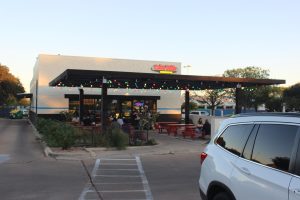Austin Curbside Composting Program local expansion
May 7, 2021
At the beginning of 2021, the Austin Resource Recovery, a department of the City of Austin that helps manage local waste to provide resources for the local community, released its final part of the Curbside Composting Collection Program. The program has been developed over the past four years to provide a composting service to all Austin residents, and this final part expanded the service to over 55,000 households in Austin, including those within Bowie’s region.
The program is part of a larger initiative to cut down waste and decrease the amount of garbage in landfills around Austin. At school, Bowie follows the Austin Independent School District’s (AISD) Zero Waste Initiative, an program that works to compost and recycle in school cafeterias, and has a goal to decrease landfill waste by 90% by 2040. Junior Taru Mishra, who is a member of the JBHS Earth Club, shares her thoughts on Bowie’s implementation of AISD’s current environmental plan.
“I think Bowie needs to focus on managing its trash and waste materials by increasing the number of recycling bins,” Mishra said. “This needs to be paired with increased education of people at Bowie regarding what materials can be recycled and what cannot.”
In terms of composting at Bowie, English teacher Kimberly Wiedmeyer describes the necessity of implementing a composting program on campus.
“I see students throw away huge amounts of food constantly: three students will get single servings of fries, each eats a couple, and then they’ll throw them away,” Wiedmeyer said. “I really struggle with this attitude and mindlessness about our agricultural system and lack of understanding of how this impacts our environment. For that reason, I think implementing a compost system in Bowie would heighten awareness and create a way to beneficially re-purpose this food waste.”
Although Bowie doesn’t have a composting system yet, senior Liana Chen, who founded the JBHS Eco-Team, hopes that with this expansion of the Curbside Collection Program, there will be more support to add one on campus as well.
“I think the new Austin composting system is beneficial because it will increase the number of people who compost which reduces the city’s trash and increases support for composting,” Chen said.
Every household that utilizes the Curbside Composting Collection Program is given a green bin, similar to a trash can bin. Residents will then collect food scraps, yard trimmings, and food-soiled paper in the bin.
“[Residents] can simply have carts that allow them to carry their compost on a regular basis,” Mishra said. “This will encourage more people to compost and reduce the amount of waste that ends up in landfills, limiting the risk to potentially pollute marine and other animal habitats.”
Although the carts cost an additional $5 per month for the service, many believe that the benefits of composting outweigh the costs. According to the United States Environmental Protection Agency (EPA), composting helps enrich soil, reduce the need for chemical fertilizer, and encourages the production of beneficial bacteria. Moreover, the carts are picked up once a week with the regular trash bin on the same day as the regular trash collection, so residents simply have to put the bin outside their homes.
“As a city, it’s more convenient for the state to provide the composting bins because it’ll increase the number of people who compost,” Chen said. “Composting doesn’t require much effort and with Austin’s new plan, it’ll be even easier.”
While the system’s goal is to decrease the amount of land waste in landfills, it has yet to expand its services to all Austin residents. Although Mishra’s household isn’t included in the Curbside Compost Collecting Program, she described other methods that the city can get its residents to compost, even if they aren’t involved in the program.
“For those whose communities are not included in the current compost initiative, the City of Austin could maybe provide information about how to set up composting in one’s own home or area,” Mishra said. “[The city could] add posters throughout the communities to ensure that people are properly educated in what they are doing in regards to compost.”
Nevertheless, there are other ways to compost in Austin, including creating an individual composting system or dropping it off at designated locations established by the Austin Resource Recovery, such as farmers markets or community gardens.
“Food waste is one of the biggest contributors to global warming, and it’s something we all need to be more aware of,” Wiedmeyer said. “If we do throw out food, we can use composting to mitigate some of the negative impacts.”
Aside from Austin residents composting through the program, science teacher Daniel Chonis believes that the goal of composting must be expanded even further in order to help meet the goal of decreasing landfill waste.
“I would also shift the focus away from the individual being solely responsible for reducing waste and hold businesses, companies, and corporations to a higher standard in terms of waste output,” Chonis said. “These are main contributors to waste even though the blame is often put on the citizens.”
As Austin increases its Curbside Composting Collecting Program in the future, Chonis reiterates the need for composting in our environment in order to keep it healthy for the years to come.
“As guests on this planet, I feel we have a duty to protect the environment and develop ways to coexist with nature without exhausting all of its resources,” Chonis said. “If we want to continue our stay on this planet, then I believe that we need to treat our environment, and overall world, with more empathy and respect.”









